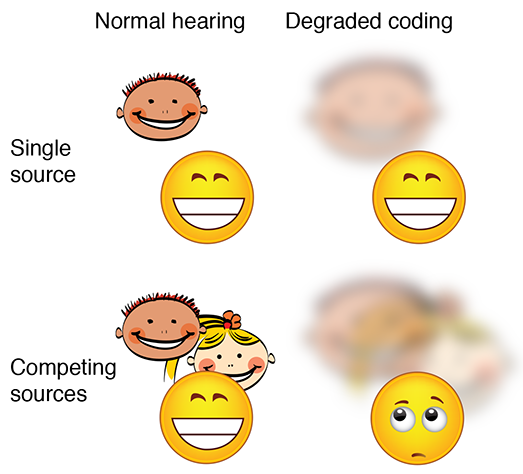Hearing related complaints are some of the most common disabilities reported by Service Members and Veterans. Many Veterans and Service Members report having the "cocktail party problem," which describes a difficulty in communicating in crowded settings or following a conversation in noisy environments. The problem highlights the importance of not only being able to hear the speech but also the ability to selectively attend to the conversation of interest while ignoring extraneous sounds present in the environment. Although this difficulty has an enormous impact on an individual's ability to interact with others in a social setting, the precise injuries leading to this deficit are not fully understood. Because Service Members' have an increased risk of exposure to both dangerous levels of noise as well as blast-related events throughout their careers, it remains unknown if this communication problem is the result of traditional hearing loss, associated with damage to the sensory processing components of the ear, or if it is the result of damage to the cortical brain networks associated with attentional control.
To investigate this question, researchers at the Center for Research in Sensory Communication and Emerging Neural Technology at Boston University assessed Veterans with a history of blast exposure for their performance and cortical brain responses to an auditory selective attention task. Cortical responses measured using electroencephalography (EEG) were used to quantify the strength of neural responses to sound and how these responses are modulated by attentional focus. In addition, participants received standard hearing assessments.
Blast-exposed Veterans included in this study reported having trouble following conversations in situations with multiple speakers or interfering sounds; yet, objective hearing assessments did not reveal differences in hearing thresholds between blast-exposed Veterans and the control population. However, blast-exposed Veterans performed significantly worse on measures of selective attention. Their reduced performance was accompanied by weaker neural responses, as measured by EEG, and reduced attentional modulation of these neural responses.
The researchers interpret these results to suggest that communication problems reported by the Veterans cannot simply be explained by compromised auditory sensory processing components of the ear, but may rather be explained by blast-induced damage to cortical networks associated with the control of attention. These results provide evidence for the cortical basis for the difficulties these Veterans are experiencing in communicating in everyday social settings in the presence of competing, distracting sounds. Additional work is needed to rule out the influence of possible confounds including posttraumatic stress disorder (PTSD), other traumatic brain injury (TBI) induced cognitive deficits, and/or sleep or substance abuse disorders. Future work that isolates the root cause of these cognitive deficits is critical for developing therapeutic interventions that address these communication deficits and ultimately improve Service Members' quality of life.

Bressler S, Goldberg H, Shinn-Cunningham B. (2017). Sensory coding and cognitive processing of sound in Veterans with blast exposure. Hear Res. 349:98-110. doi:10.1016/j.heares.2016.10.018.
Your 15 minute session will timeout in approximately 10 minutes.
If you're in the middle of entering information, please close this warning and save your progress (if possible) or finish up your task.
If your session fully times out, you will lose any un-saved work.
Your current Blast Injury Research Program session has expired.
Your next click will take you away from the private area, and you will lose any work you have in-progress.
Please enter your email address, and try again.